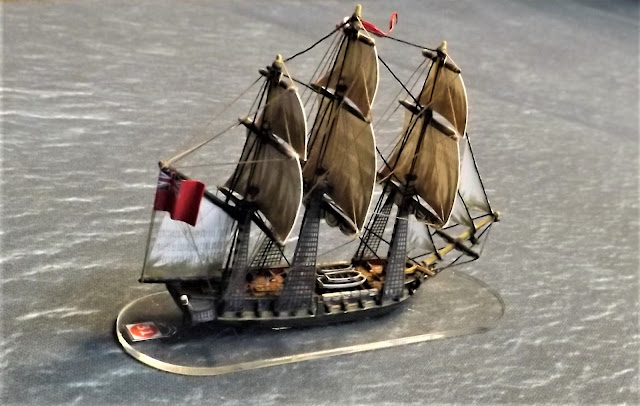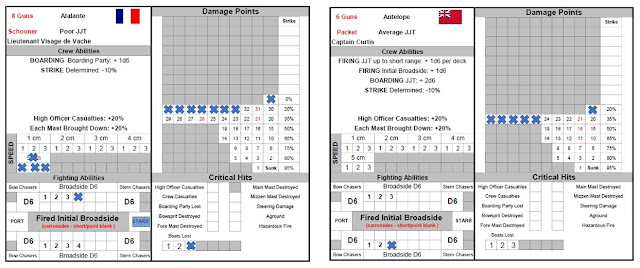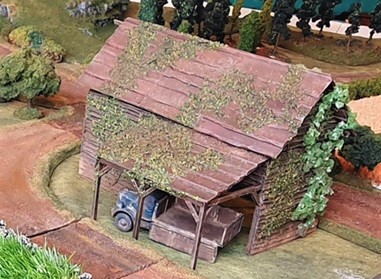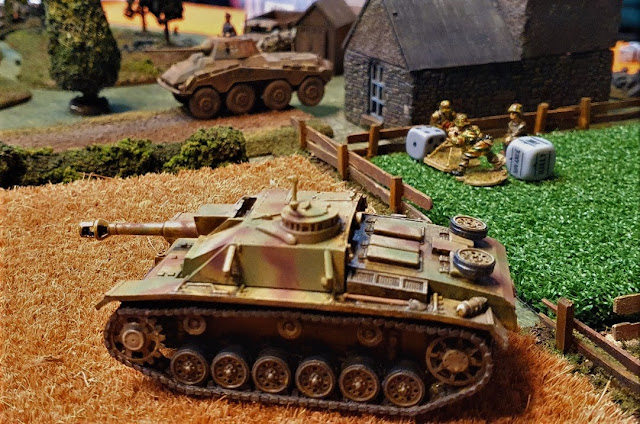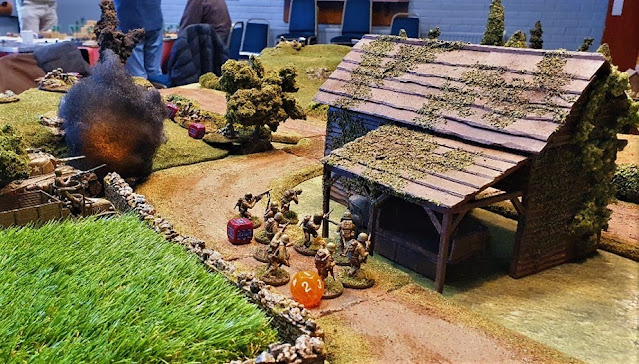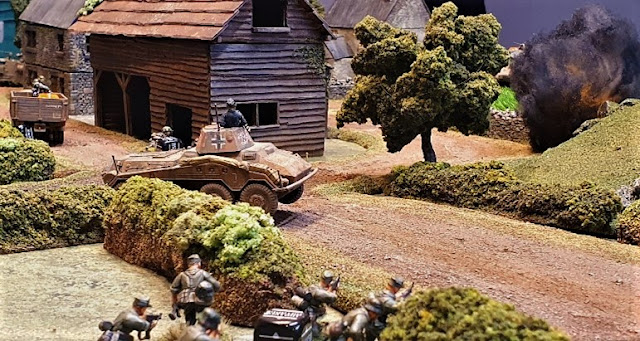 |
| HMS Nymphe in action with Cléopâtre off Start Point, 18th June 1793 - Derek Gardner |
Whilst working on various fleet and campaign projects for the 1:700 collection of age of sail ships I've been equally focussed on developing a collection of small ship actions picking up on some work from early last year using ideas from various additional rule sets to Kiss Me Hardy (KMH) such as To Covet Glory (TCG), the small ship additional rules for KMH developed by Chris Stoesen and Narrow Seas from Curs'd Captain, both available on Wargames Vault.
As a basis for this collection I have taken the classic accounts from William James, 'The Naval History of Great Britain' and the compilation of his work done by Sapherson & Lenton in their Raider Games publication 100 Small-scale Actions as a start point and worked those actions up into a set of scenarios designed to work with my rule adaptions.
This series of three games played at the club with Steve L and Paul as volunteer play testers gave me chance to test out these ideas on the table to see what works and what doesn't work quite so well and other ideas the chaps could come up with.
 |
| Start Point, South Devon, seen during mine and Carolyn's visit to this gorgeous part of Summer South Devon last year, and the scene of this famous naval action from the French Revolutionary War. JJ's Wargames - Start Point, Hallsands and Slapton Sands |
Last summer Carolyn and I visited Start Point, the most southerly point in Devon and from where in the summer of 1793, casual promenade's such as us could have witnessed out on the horizon, the gun flashes and rumble of heavy cannon that would have accompanied the drama of our first action.
'On the 17th of June the British 12-pounder 36-gun frigate Nymphe, Captain Edward Pellew, sailed from Falmouth on a cruise. Having, in his way up the Channel, arrived nearly abreast of the Start point. Captain Pellew ran out to the southward in the hope of falling in with one of the two French frigates which, a week or two before, the Nymphe and Venus had chased into Cherbourg, and which were known to be the Cléopâtre and Semillante, already noticed in the action between the latter and the Venus.
On the next day, the 18th, at 3 h. 30 m, A.M., the Start point bearing east by north, distant five or six leagues, a sail was discovered in the south-east quarter. At 4 A.M. the Nymphe bore up in chase under all sail; the stranger, which, by a singular coincidence, was the French frigate Cléopâtre, carrying a press of canvas, either to get away or to prepare for action. At 5 A.M., finding that the Nymphe had the advantage in sailing, the Cléopâtre hauled up her foresail and lowered her topgallant sails, bravely awaiting the coming up of her opponent. At about 6 A.M., the Nymphe approaching near, the Cléopâtre hailed her; but Captain Pellew, not hearing distinctly what was said, replied only by the usual "Hoa! hoa!" an exclamation instantaneously followed by three cheers from the crew of the Nymphe.
 |
Captain Mullon, upon this, came to the gangway, and, waving his hat, exclaimed, " Vive la nation !" |
Captain Mullon, upon this, came to the gangway, and, waving his hat, exclaimed, " Vive la nation!" and the crew of the Cléopâtre, at the same time, put forth a sound which was meant for an imitation of the cheers of the British.
At 6h. 15 m. A.M., the Nymphe having reached a position from which her foremost guns would bear on the starboard quarter of the Cléopâtre, Captain Pellew, whose hat, like that of the French captain, was still in his hand, raised it to his head, the preconcerted signal for the Nymphe's artillery to open.
A furious action now commenced, the two frigates still running before the wind, within rather less than hailing distance of each other. At about 6h. 30 m. the Cléopâtre suddenly hauled up eight points from the wind; and, before 7 a.m., her mizenmast (about 12 feet above the deck) and her wheel were shot away. In consequence of this double disaster the French frigate, at about 7 A.M., paid round off, and shortly afterwards fell on her antagonist, her jib-boom passing between the Nymphe's fore and main masts, and pressing so hard against the head of the already wounded mainmast, that it was expected every instant to fall; especially as the main and spring stays had both been shot away.
 |
| Ship plan of the captured Cléopâtre, renamed Oiseau in the Royal Navy - RMG |
Fortunately, however, for the Nymphe, the jib-boom of her adversary was carried away and her own mainmast preserved. After this, the two frigates fell alongside, head and stern, but were still held fast, the Cléopâtre's larboard main topmast studdingsail boom-iron having hooked the larboard leech-rope of the Nymphe's main topsail. Here again was danger to the mainmast. In an instant a maintopman named Burgess sprang aloft and cut away the leech-rope from the end of the mainyard; and, as an additional means of getting the ships apart, Lieutenant Pellowe, by Captain Pellew's orders, cut away the best bower anchor. During these important operations no relaxation had occurred on the part of the British at least, in the main purpose for which the two ships had met.
Soon after they had come in contact in the manner we have related, the Cléopâtre was gallantly boarded by a portion of the Nymphe's crew; one man of whom, at 7 h. 10 m. A.M., hauled down the republican colours, after the action had continued 50 minutes. The firing now ceased, and it was just as the last of 150 prisoners had been removed into the Nymphe that the two ships separated.
. . . The loss on the Nymphe was tolerably severe. Out of a crew of 240, men and boys, she had her boatswain (Tobias James), one master's mate (Richard Pearse), three midshipmen (George Boyd, John Davie, and Samuel Edfall), 14 seamen, and four private marines killed, her second-lieutenant (George Luke), two midshipmen (John A. Norway and John Plaine), one lieutenant of marines (John Whittaker), 17 seamen, and 6 private marines wounded; total, 23 killed and 27 wounded.
The loss on the Cléopâtre, in killed and wounded together, out of a crew, as certified by her surviving officers, of 320, men and boys, amounted to 63. Among the wounded were included the ship's three lieutenants, and among her killed was the truly gallant Captain Mullon. A round shot had torn open his back and carried away the greater part of his left hip. It is related that, having the list of coast-signals adopted by the French in one of his pockets, Captain Mullon, during his short agonies, drew forth a paper, which he imagined was the right one (but which really was not), and died biting it to pieces. Here was a trait of heroism! And yet no French writer, as far as we can discover, has recorded the fact.'
The setup map below has Cléopâtre on gate 8 able to position herself within a 12 inch square corner of the table with her bow facing one of two opposite gates and with the wind on her quarter. Nymphe was then set up similarly on gate 6 before each player issued their sailing orders, by placing a card choice face down declaring their intention to sail straight ahead allowing for a deviation starboard or larboard (right or left for you lubbers) two centimetres, a turn to starboard or larboard, requiring the vessel to turn at least 3cm of its move in the direction selected, and if intending to pass the bow through the wind to order a tack - simples!
 |
| Each scenario comes with a table 'gate' plan used for setting up and identifying potential escape routes should one party decide to attempt to withdraw. |
These simple order declarations together with the chit draw to decide order of activations and game events take away the need to write detailed movement orders but add all the inherent misfortunes of choosing the wrong move after seeing what your opponent has selected combined with your firing and movement activation chits not quite coming out the bag in the order you would have preferred.
Obviously in the early approach moves the movement order and sailing decisions are not quite as vital as when the ships start getting into combat range and the tension this causes is only heightened by the need to identify a likely opponent as the enemy, as evidenced by the accounts in James with French frigates unsure of their companion very often flying a blue flag run up at the mizzen combined with the firing of two guns, as an example of French challenges to an unidentified stranger.
The failure to respond with the appropriate signal in a timely fashion being met with a follow up broadside if not already answered with one by an enemy now convinced by the strange signal that the other is unfriendly.
Of course identifying an enemy before your opponent bestows a certain if likely temporary advantage that may be capitalised on if the activations come out in the right order, so the result is the 'cat and mouse approach' of two cautious strangers, trying to keep their guns bearing so as not to be caught out, that must have been played out on the high seas numerous times during the wars at sea under sail.
 |
| Is she French, is she British? Keep the guns bearing while we look for clues. |
In our refight it was Pellew's Nymphe who spotted the identity of his opponent first and unwilling to wait the outcome of the next turns activations chose to announce his discovery by letting fly with his nine-pounder brass bow chasers inflicting a single hit but alerting Captain Mullon that any further tests to acquire the now confirmed enemy, having run up his colours, were unnecessary.
 |
| With the identity of the Cléopâtre confirmed Pellew orders a ranging 'salute' from the bow chasers to start our battle refight. |
Of course having sighted each other over three hours previously the scenario assumes both ships had beaten to quarters with guns run out, armed and manned ready to fight, and so as soon as the turn in which Nymphe announced her identity both ships were now ready to unleash their opening broadsides at the first opportunity, which Cléopâtre was able to do by her canny turn across the oncoming Nymphe, but still far enough away to limit the damage a much closer shot might have caused.
If a scenario sees a side quite clearly caught by surprise, the side concerned can be required to roll a certain die (d-average, d6, d8 or d10) to decide how many turns will be required to clear for action, only allowing the affected party to fire partial broadsides (half effect basically) until the decks are cleared.
 |
| With the first shots of Pellew's bow chasers both ship's gun decks ready themselves for the order to fire |
 |
| What's the range gun captain? |
The two frigates wheeled around the table trying to get the wind and the best possible fire solutions, causing a gradual attrition of hull hits that saw the first gun boxes crossed off but with both sides unable to convert the critical hit numbers to cause that extra damage.
 |
| Cléopâtre returns Pellew's salute and battle is joined. |
However the occasional broadside to broadside exchanges at effective range started to favour the better British crew and sensing the slight advantage, Pellew chose to throw caution to the wind, quite literally as he took advantage of a quartering wind to bear down on the Cléopâtre firing his bow chasers and braving the return broadside to use the added speed to swing broadside across the Frenchman's bow before unleashing a staggering close in bow rake that effectively sealed the decision to conclude the fight by grappling and boarding.
 |
| 'A furious action now commenced, the two frigates still running before the wind, within rather less than hailing distance of each other.' |
 |
| Quarterdeck view, MFN Cléopâtre - Peter Dennis |
The bow rake caused the Cléopâtre to require a strike test on the next strike chit drawn, which she passed with a cheer from the French crew.
 |
| The mutual exchanges of broadsides started to favour the better British crew as both sides softened the other up. |
 |
| Firing his bow chasers as he runs in on the wind, Pellew braves Mullon's return broadside to get in close for a bow rake. |
 |
| The inevitable return French broadside is just beyond short range and out of arc to claim a rake. |
With Cléopâtre still reeling from the bow rake, but no doubt buoyed by the passing of the strike test that followed soon after, the Nymphe attempted to grapple as she passed, and living up to his namesake Mullon was up for the challenge, also opting to grapple thus making an easy preparation for the boarding action to come.
 |
| Pellew forces Nymphe across the bows of Cléopâtre to deliver a crushing bow rake and prepares to grapple |
As it happened the first chit out of the bag on the next turn was a boarding action and the Nymphe's proved irresistible, (27 points to 18) storming over theirs and the Cléopâtre's bulwarks to capture the top deck before heading down the hatches on to the gundeck below.
A second round of gunfire followed in the wake of the fighting above that saw both sides take further hits on the hull before the next round of boarding concluded matters as the Nymphe's proved unstoppable winning the fight 25 points to 12 and causing Captain Mullon to step forward and offer his sword.
 |
| The final embrace as the 'Nymphes' storm over the bulwarks to force the Cléopâtre to strike! |
So as in the historical encounter Sir Edward Pellew and Nypmhe came out the victor although Cléopâtre kept all her masts and Captain Mullon didn't get the wrong side of a 12-pounder ball, but how well did our British frigate do in terms of the outcome overall?
Victory Calculation
Each side scores victory points (VPs) for
- every ship they brought to the Action – even if she struck or was captured and
- for every enemy ship they captured. (Thus, captured ships are scored by both their captors and their original owners.) The high total wins.
The victory point value for each ship is her Hull size multiplied by her Value (5 plus or minus value modifiers). The following modifiers may increase a ship's value with no upper limit but may never reduce it below x 1.
Owner of Vessel
Hull Size x 5
Less either Damage/Casualty Factor
Or if greater, the Disgrace Factor
- -1 if part of a group and she escaped first, or escaped before half of her sisters
- Sovereignty 1: Warships can suffer -1 disgrace in their home waters.
- Sovereignty 2-3: Warships can suffer -2 disgrace in all waters if the enemy side has a lower sovereignty value.
If the enemy side has an equal or higher sovereignty value, they can suffer -2 disgrace in home waters, and -1 elsewhere.
And all the following that apply
- -1 Damage per quarter of basic speed lost, round up.
- +1 Over-matched if her side committed fewer ships per player than the enemy.
- +1 in Home Waters if she carries any cargo.
- +1 Carriage, per level of cargo transported through the gate opposite her entry, or the gate to either side of it.
Captor of Vessel
Hull Value x 5
Less
- Damage/Casualty Factor -1 to -4
Plus
- Cargo Value
Thus the Nymphe being a 36-gun frigate has a Hull Value of 6 x 5 = 30 VP
Damage limited to less than light damage, and no disgrace incurred.
Plus the captured and damaged Cléopâtre' worth another 15 VP
British Total 45 VP
The Cléopâtre's being a 32 gun frigate has a Hull Value of 5 x 5 = 25 VP
but having suffered medium damage with the last two hits taking her into that level her multiplier reduces to 3 thus netting 15 VP
French Total 15 VP
These duels and chase actions are designed to be short play encounters but including the historical factors that impacted the captains involved and so during our afternoon we played another two from the first year of the French Revolutionary War.
Our next action shifted to the Caribbean, off a very famous harbour in Cuba, formerly known as Cumberland Harbour, but better known today as Guantanamo Bay. William James tells the account of a a famous action fought by the brave packet ship Antelope.
 |
| The Galant Action between His Majesty's Packet Antelope & the French Privateer L'Atalante - 2nd December 1793 |
'On the 1st of December his Britannic majesty's packet the Antelope, Captain Curtis, being off Cumberland harbour, in Cuba, on her way to England, from Port-Royal, Jamaica, which port she had quitted three days previous, fell in with two French schooner-privateers, of formidable appearance.
The packet immediately bore up for Jamaica, and was followed, under all sail, by the privateers. The Atalante, one of the two, outsailing her consort, continued the chase alone. During that and the following day, until 4 p.m., the packet rather gained upon her pursuer; but the wind suddenly failing, the latter took to her sweeps, and soon swept up alongside of the Antelope.
At last, the privateersmen, finding they had caught a tartar, cut the grapplings, and attempted to sheer off. The boatswain, observing this, ran aloft, and lashed the schooner's square-sail yard to the Antelope's fore shrouds. Immediately a well-directed volley of small arms was poured into the privateer, and the crew called for quarter. This, notwithstanding the Atalante had fought with the red or bloody flag at her mast-head, to indicate that no quarter would be shown by her, was granted, and possession was forthwith taken of the prize.
 |
| The Chase setup sees the 'quarry placed at a choice of gate based on the prevailing wind, followed by the chaser selecting an entry point behind to potentially intercept. |
The Antelope mounted six 3-pounders and had sailed with 27 hands; but she had lost four by the fever, and two were ill in their hammocks, consequently the packet commenced the action with only 21 men, exclusive of the passengers. Her total loss in the action was three killed, and four wounded.
 |
| Antalante having taken the worst of the bow and stern chaser sniping desperately attempts to slow the merchantman with a despairing broadside designed to cut up the rigging. |
The Atalante mounted eight 3-pounders; and her complement was 65 men, composed of French, Americans, and Irish. Of these the first and second captains and 30 men were killed, and 17 officers and men wounded. The Atalante had been fitted out at Charleston, in the United States.
The Antelope now carried her prize in triumph to Annotto Bay, Jamaica, where the two vessels arrived on the morning succeeding the action.' (James' History Vol I)
Again the numbers help tell a story that I hadn't quite appreciated while we were playing this scenario
Thus the Antelope being a small merchantmen has a Hull Value of 4 x 5 = 20 VP
Plus a Cargo Value of 1 (carrying Important Persons and Military Dispatches)
Less -2 for the medium damage suffered from the fire of the Atalante.
Note Merchants have no Sovereignty Value
British Total 16 VP
The Atalante being a light fast schooner has a Hull Value of 2 x 5 = 10 VP
Less -1 having suffered light damage from the hits scored by the Antelope
French Total 8 VP
Thus with the escape of the Antelope and the damage she inflicted on the privateer Antelope is credited with a Decisive Win, not quite the Resounding Win she achieved historically.
 |
| Action between HMS Venus and the Semillante, 27th May 1793 - Thomas Elliott |
Our final scenario of the day preceded our first and is mentioned in James' commentary as it was the Semilliante together with the Cléopâtre that had been operating together in their attempts to attack and take British merchants in the Channel and Western Approaches.
James recounts the encounter with Venus 32-guns under the command of Captain Jonathan Faulknor;
'On the 27th of May, at about 1 a.m., Cape Finisterre bearing south, 58° east, distant 125 leagues, the British 12-pounder 32- gun frigate Venus, Captain Jonathan Faulknor, and the French 36-gun frigate Semillante, mounting 40 guns, Captain Gaillard, descried each other.
 |
| Venus vs Semillante, 27th May 1793, 0100, 480 Miles NW of Finisterre |
At 3h. 30m. a.m. the Venus tacked; and at 4 a.m. the Semillante, having bore down to reconnoitre the stranger, passed to windward of her. The Semillante soon afterwards hoisted a blue flag on the mizen-peak, and fired two guns to leeward, in quick succession. Upon this, the Venus hoisted her colours, and returned a shot to one which the Semillante had just before fired to try her adversary's distance. At 4 h. 30 m. A.M. the Semillante tacked for the Venus, who kept her wind, and carried sail to get the weather gage; but the former, unwilling to give up that advantage, also kept her wind. At 7h. 30 m. A.M. the Semillante fired a few random shot, and at 8 A.M. dropped nearer to the Venus; when the latter opened her fire, and a warm cannonade ensued. The two ships gradually neared each other until 10 a.m., when they were scarcely half a cable's length asunder.
The Semillante, by this time, had lost her first and second officers, and had her masts, yards, sails, rigging, and hull much damaged by shot; and her guns, for the last half-hour had made no return to the vivid fire kept up by the Venus. In this state, the Semillante, very naturally, strove to disengage herself from the combat. On observing her opponent's intention, the Venus trimmed her sails as well as she was able, and, ranging up alongside, gave the Semillante a well shotted broadside; then dropped a little astern, and was in the act of again shooting a-head to repeat her fire, when she discovered to leeward a large ship under French colours.
The Semillante, as if recognizing the stranger, bore up to join her; while the Venus, whose cross-jack yard, gaff, and main rigging, were entirely shot away, and whose masts, yards, sails, and rigging in general were much cut and injured, hauled as close to the wind as her crippled state would permit. Thus ended the action; and at that moment, according to the testimony of the master of an English merchantman, who was then on the Semillante, the latter had five feet water in her hold.
As a British 32-gun frigate, the Venus was an anomaly in point of armament, mounting 24 instead of 26 long 12-pounders on the main deck; which, with eight long 6-pounders and six carronades, 18-pounders, on the quarter-deck and forecastle, gave her a total of 38 guns. Her complement, excluding the Widow's men, was 231, fourteen more than the establishment of her class. Not having a marine, and being 20 seamen short, the Venus commenced action with only 192 men and boys. Of these she had two seamen killed, her master, and 19 seamen wounded.
The loss on the Semillante (whose force has already been stated), out of a crew of at least 300, amounted to 12 officers, seamen, and marines, killed, and 20 wounded.
. . . A letter, extracted from the Moniteur of June 8, 1793, identifies the Semillante, beyond all doubt, as the ship engaged by the Venus.
Comparative Force of the Combatants.
Venus. Semillante.
Broadside-guns No. 19 20
Lbs. 222 279
Crew No. 192 300
Size tons 722 940
Making some allowance for the disparity in point of crew, we may consider these as a tolerably well-matched pair of combatants; and it undoubtedly was a well-fought battle. Had the second French ship (for, although the French commander's letter mentions no strange vessel, yet the fact being noted in the log-book of the Venus, does not admit a doubt), and which ship was subsequently ascertained to have been the 36-gun frigate Cléopâtre, Captain Jean Mullon, delayed her appearance for about half an hour, the probability is, that the Semillante, having suffered most in the action, would have become the prize of the Venus. The Cléopâtre crowded sail after the latter; but the Venus being far to windward, and having a smooth sea and a commanding breeze, got clear off; rejoining, at 3 p.m. on the 29th, her consort, the 36-gun frigate Nymphe, from whom, two days previous to the action, she had parted company in chase. (James' History Vol I)
The set up below sees the Semillante to windward of the Venus as the two ships search for the other in the darkness of the North Atlantic, with thus a need not only to get close enough to confirm the identity of the other but also to maintain contact to be able to fire in the dark.
We had a +1 modifier for identifying the enemy to allow for the night conditions and we used Nick Skinner's visibility rules that he introduced for the Cape Finisterre (Calder's Action) scenario and which played really well in our game in January.
In addition the proximity of another French ship close by, thought to be the Cléopâtre that came to the rescue of Semillante in the historical encounter has to be accounted for with a time limit of the action to force, certainly, the British player to get on with things to avoid interference from the other ship.
 |
| The flash of the main guns on Venus split the night as another broadside slams into the Semillante |
With the French frigate reeling under the blows like a boxer on the ropes and with the clock ticking in terms of Cléopâtre coming to the rescue, Venus closed in for the grapple and boarded, taking the Frenchman in two rounds with a turn to spare before game end.
Victory Calculation
Each side scores victory points (VPs) for
- every ship they brought to the Action – even if she struck or was captured and
- for every enemy ship they captured. (Thus, captured ships are scored by both their captors and their original owners.) The high total wins.
The victory point value for each ship is her Hull size multiplied by her Value (5 plus or minus value modifiers). The following modifiers may increase a ship's value with no upper limit but may never reduce it below x 1.
Owner of Vessel
Hull Size x 5
Less either Damage/Casualty Factor
Or if greater, the Disgrace Factor
- -1 if part of a group and she escaped first, or escaped before half of her sisters
- Sovereignty 1: Warships can suffer -1 disgrace in their home waters.
- Sovereignty 2-3: Warships can suffer -2 disgrace in all waters if the enemy side has a lower sovereignty value.
If the enemy side has an equal or higher sovereignty value, they can suffer -2 disgrace in home waters, and -1 elsewhere.
And all the following that apply
- -1 Damage per quarter of basic speed lost, round up.
- +1 Over-matched if her side committed fewer ships per player than the enemy.
- +1 in Home Waters if she carries any cargo.
- +1 Carriage, per level of cargo transported through the gate opposite her entry, or the gate to either side of it.
Captor of Vessel
Hull Value x 5
Less
- Damage/Casualty Factor -1 to -4
Plus
- Cargo Value
Thus the Venus being a 32-gun frigate has a Hull Value of 5 x 5 = 25 VP
Damage limited to less than light damage, and no disgrace incurred.
Plus the captured and damaged Semillante' worth another 10 VP
British Total 35 VP
The Cléopâtre's being a 32 gun frigate has a Hull Value of 5 x 5 = 25 VP
but having suffered heavy damage sees her multiplier reduces to 2 thus netting 10 VP
French Total 10 VP
Note, I didn't include the fact that Venus was outnumbered as she wouldn't have known that until the other ship was spotted so wouldn't have been a factor in this night time battle.
Thus a resounding victory to Captain Faulknor and the Venus, managing to outperform the historical result by capturing her adversary.
This series of games was really helpful in clarifying my thinking on the structure of the thirty scenarios written so far with ideas generated for a few tweaks which will provide plenty of material for future games.
I love playing these small encounters which produce an entirely different game to the larger squadron and fleet actions, but like the real thing are a great training ground for understanding the principles of firing close in to soften the enemy up before boarding and taking him, something that applies equally between the bigger ships.
Thank you to both Paul and Steve L for patiently getting their heads around each scenario as we worked on them and for providing all the fun, cheers guys.
More anon
JJ








